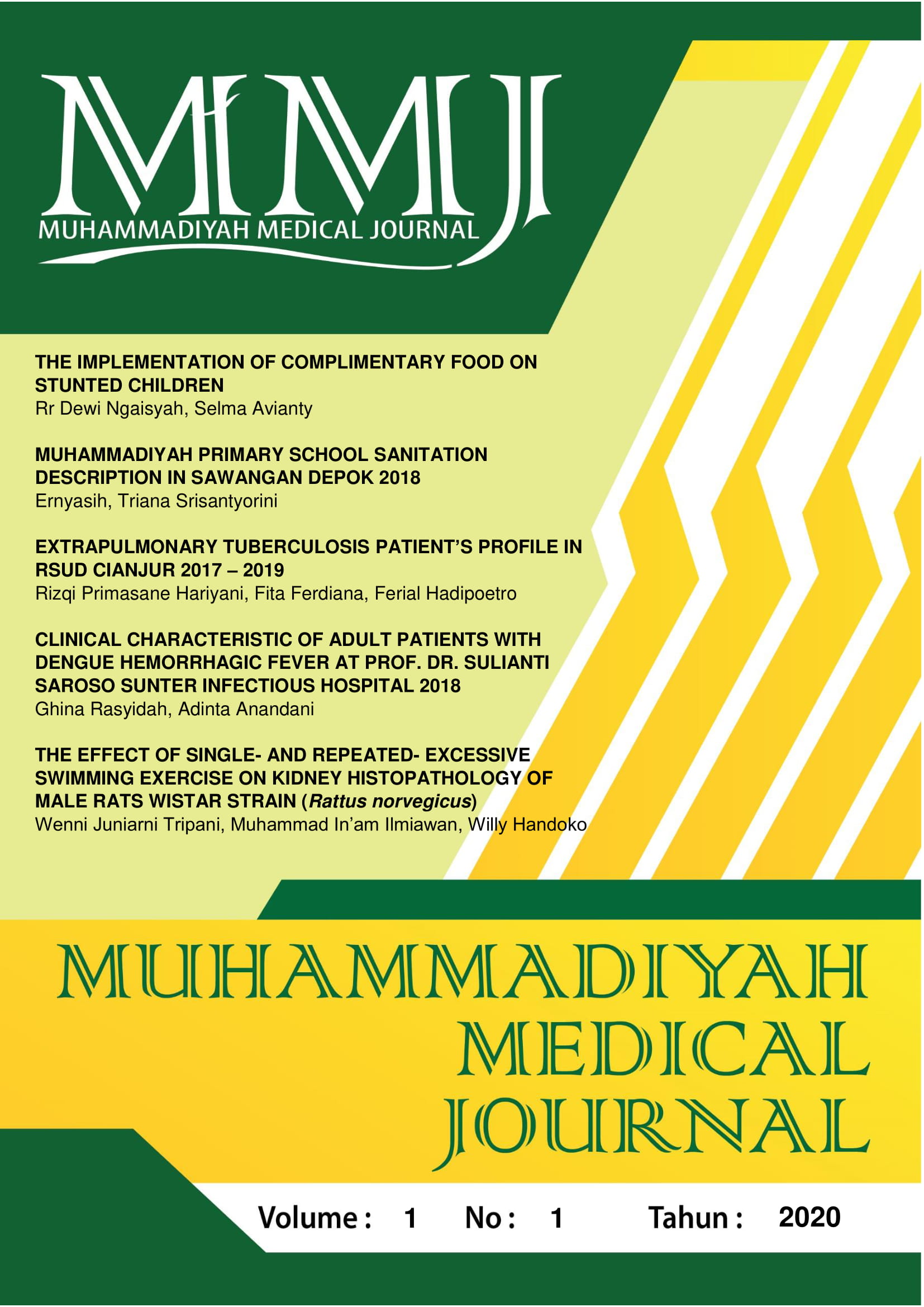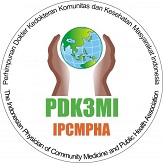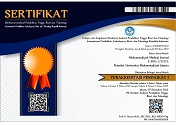THE EFFECT OF SINGLE- AND REPEATED- EXCESSIVE SWIMMING EXERCISE ON KIDNEY HISTOPATHOLOGY OF MALE RATS WISTAR STRAIN (Rattus norvegicus)
DOI:
https://doi.org/10.24853/mmj.1.1.33-42Keywords:
Single- and Repeated- Excessive Swimming Exercise, Kidney Histopathology, Male Wistar Strain RatsAbstract
Background: Physical exercise aims to improve or maintain physical fitness. However, excessive physical exercise may cause increase of oxidative stress which leads to cellular injury, including in the proximal tubules of kidney. This research aims to find out the effect of single- and repeated- excessive swimming exercise to the kidney histopathology of male wistar rats (Rattus norvegicus). Methods: This research was an experimental study with complete random and post test only control group design. Twenty seven male wistar rats were divided into three treatment groups: control group, single- excessive swimming exercise group (45 minutes for one day), and repeated- excessive swimming exercise group (45 minutes/day for seven days). In the end of the treatment, the kidney of the rats were taken to be analyzed by using hematoxylin-eosin stain. The mean of proximal tubules injury of kidneys were counted by two observers using blinded method. Data were analyzed by using one way anova test. Result: The analysis showed there was a significant difference in the mean percentage of proximal tubules injury between control group and single swimming group as well as the repeated swimming group (Anova p=0,000), also there was significant difference between the treatment groups (p=0,020). The highest average of proximal tubules injury was in the single swimming group. Conclusion: Single- and repeated- excessive swimming exercise causes the proximal tubules injury of kidney.References
American College of Sports Medicine (Indianapolis Ind), Pescatello L, Deborah R, Paul D. ACSM’s guidelines for exercise testing and prescription. Baltimore, MD: Wolters Kluwer, Lippincott Williams & Wilkins; 2014.
Vina J, Olaso G, Arc-Chagnaud C, de la RA, Gomez-Cabrera M. Modulating oxidant levels to promote healthy ageing. Antioxid Redox Signal. 2020;
Matos N, Winsley R, Williams C. Prevalence of nonfunctional overreaching/overtraining in young English athletes. Med Sci Sport Exerc. 2011;43:1287–94.
Kreher JB, Schwartz JB. Overtraining Syndrome: A Practical Guide. Sports Health. 2012;4(2):128–38.
Fogarty M, Hughes C, Burke G, Brown J, Trinick T. Exercise-induced lipid peroxidation: implication for deoxyriibonucleic acid damage and systemic free radical generation. Env Mol Mutagen. 2011;52(35–42).
Nayanatara A, Nagaraja H, BK A. The Effect of Repeated Cold Water Swimming Exercise on Adaptive Changes in Body Weight in Older Rats. Thai J Physiol Sci. 2005;18(1):3–9.
Silverthorn D, Johnson B, Ober W, Garrison C, Silverthorn A. Human physiology: an integrated approach. 6th ed. Boston: Pearson Education; 2013. 890 p.
Olivia N. Pengaruh pemberian vitamin E terhadap gambaran histologis tubulus proksimal ginjal pada mencit betina dewasa (Mus musculus L) yang mendapat latihan fisik maksimal. J Ris Hesti Medan Akper Kesdam I/BB Medan. 2017;1(1):30.
Lin X, Jiang C, Luo Z, Qu S. Protective effect of Erythropoietin on renal injury induced in rats by four weeks of exhaustive exercise. BMC Nephrol. 2013;14(1).
Kim J, Lee J, Kim S, Ryu HY, Cha KS, Sung DJ. Exercise-induced rhabdomyolysis mechanisms and prevention: A literature review. J Sport Heal Sci [Internet]. 2016;5(3):324–33. Available from: http://dx.doi.org/10.1016/j.jshs.2015.01.012
Hu Y, Gursoy E, Cardounel A, Kalimi M. Biological effects of single and repeated swimming stress in male rats: beneficial effects of glucocorticoids. Endocrine. 2000;13(1):123–30.
El Abed K, Ammar A, Boukhris O, Trabelsi K, Masmoudi L, Bailey SJ, et al. Independent and Combined Effects of All-Out Sprint and Low-Intensity Continuous Exercise on Plasma Oxidative Stress Biomarkers in Trained Judokas. Front Physiol. 2019;10(July):1–10.
Bloomer R, Goldfarb A, Wideman L, McKenzie M, Consitt L. Effects of acute aerobic and anaerobic exercise on blood markers of oxidative stress. J Strength Cond Res. 2005;19(2):276–85.
Thirumalai T, Therasa SV, Elumalai EK, David E. Intense and exhaustive exercise induce oxidative stress in skeletal muscle. Asian Pacific J Trop Dis. 2011;1(1):63–6.
Sherwood L. Human physiology: from cells to systems. 9th edition. 9th ed. Boston, MA, USA: Cengage Learning; 2016. 1 p.
Kumar V, Abbas A, Aster J, Robbins S, Editors. Robbins and Cotran pathologic basis of disease. 10th ed. Philadelphia: PA: Elsevier/Saunders; 2015. 1391 p.
Davies K, Quintanilha A, Brooks G, Packer L. Free radicals and tissue damage produced by exercise. Biochem Biophys Res Commun. 1982;107(4):1198–205.
Cooper C, Vollaard N, Choueiri T, Wilson M. Exercise, free radicals and oxidative stress. Biochem Soc Trans. 2002;30(2):280–5.
Kregel K. Augmented mesenteric and renal vasoconstriction during exercise in senescent Fischer 344 rats. J Appl Physiol Bethesda Md 1985. 1995;79(3):706–12.
Bosch X, Poch E, Grau J. Rhabdomyolysis and acute kidney injury. N Engl J Med. 2009;361(1):62–72.
Petejova N, Martinek A. Acute kidney injury due to rhabdomyolysis and renal replacement therapy: A critical review. Crit Care. 2014;18(3):1–8.
Zhang M. Rhabdomyolosis and its pathogenesis. World J Emerg Med. 2012;3(1):11.
Stanković M, Radovanović D. Oxidative stress and physical activity. Sportlogia. 2012;8(1):1–11.
Di Meo S, Venditti P. Mitochondria in exercise-induced oxidative stress. Biol Signals Recept. 2001;10(1–2):125–40.
Podhorska-Okołów M, Dziegiel P, Murawska-Ciałowicz E, Krajewska B, Ciesielska U, Jethon Z, et al. Exercise-induced apoptosis in renal tubular cells of the rat. Folia Morphol. 2004;63(2):213–6.
Li XD, Sun GF, Zhu WB, Wang YH. Effects of high intensity exhaustive exercise on SOD, MDA, and NO levels in rats with knee osteoarthritis. Genet Mol Res. 2015;14(4):12367–76.
Parasmadhan R, Wijayahadi N, Maksimal AF, Total AA. Terhadap Aktivitas Antioksidan Total Darah Tikus. 2015;4(4):1393–401.
Liu J, Yeo H, Overvik-Douki E, Hagen T, Doniger S, Chyu D, et al. Chronically and acutely exercised rats: biomarkers of oxidative stress and endogenous antioxidants. J Appl Physiol Bethesda Md 1985. 2000;89(1):21–8.
Teixeira De Lemos E, Oliveira J, Páscoa Pinheiro J, Reis F. Regular physical exercise as a strategy to improve antioxidant and anti-inflammatory status: Benefits in type 2 diabetes mellitus. Oxid Med Cell Longev. 2012;
Nagaraja H, Jeganathan P. Forced swimming stress-induced changes in the physiological and biochemical parameters in albino rats. Indian J Physiol Pharmacol. 1999;43(1):53–9.
Moningka NC, Cunningham MW, Sterling M, West CA, Verlander JW, Croker BP, et al. Effects of voluntary wheel running on the kidney at baseline and after ischaemia-reperfusion-induced acute kidney injury: A strain difference comparison. J Physiol. 2013;591(5):1313–24.
Ratliff BB, Abdulmahdi W, Pawar R, Wolin MS. Oxidant mechanisms in renal injury and disease. Antioxidants Redox Signal. 2016;25(3):119–46.
Saad RA. Long term exercise preconditioning protects against renal dysfunction after ischemia reperfusion injury in rat kidneys. J Am Sci. 2014;10(6):1.
Balcombe JP, Barnard ND, Sandusky C. Laboratory routines cause animal stress. Contemp Top Lab Anim Sci. 2004;43(6):42–51.
National Research Council. Guide for the care and use of laboratory animals. National Academies Press; 2010.
Kumar R, Kumar S, Ali M, Kumar A, Nath A, Lawrence K, et al. Impact of Stress on Histology and Biochemical Parameters of Liver and Kidney of Mice. Innov J Med Heal Sci. 2012;(June):63–6.
Downloads
Published
Issue
Section
License
Authors who publish in the Muhammadiyah Medical Journal agree to the following terms:
- Authors retain copyright and grant Muhammadiyah Medical Journal right of first publication with the work simultaneously licensed under a Creative Commons Attribution Licence that allows others to adapt (remix, transform, and build) upon the work non-commercially with an acknowledgement of the work's authorship and initial publication in Muhammadiyah Medical Journal.
- Authors are permitted to share (copy and redistribute) the journal's published version of the work non-commercially (e.g., post it to an institutional repository or publish it in a book), with an acknowledgement of its initial publication in Muhammadiyah Medical Journal.








